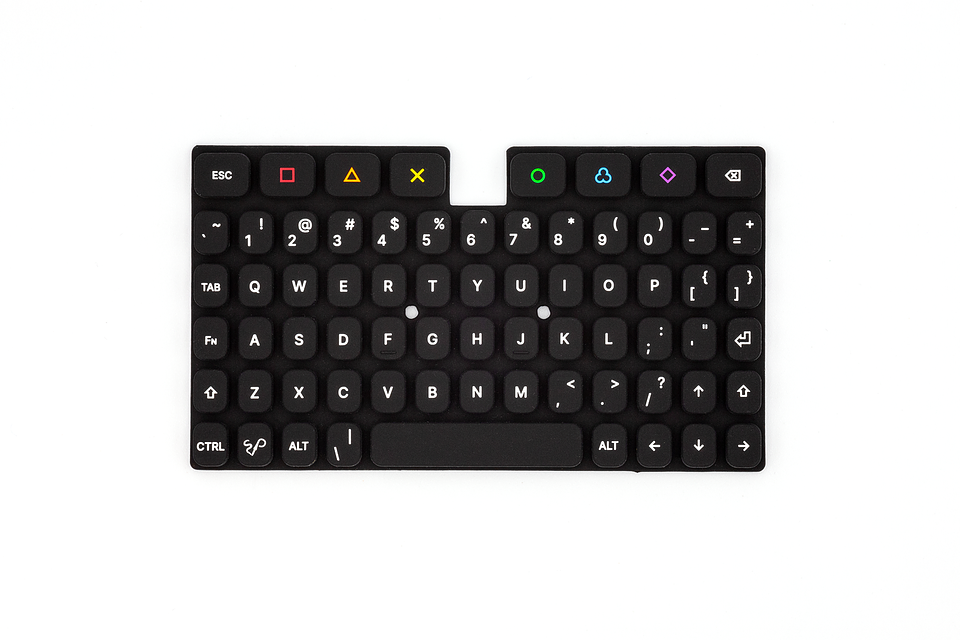KeebDeck Keyboard
Sold by Solder Party
$1.82
No tax for United States [change]
Volume discount | |
25+ items | $1.80 |
50+ items | $1.77 |
100+ items | $1.75 |
500+ items | $1.72 |
1000+ items | $1.68 |
The KeebDeck Keyboard is the result of years of research, prototyping, and evaluation to create an affordable and easily available handheld keyboard for makers and hackers. The result is a compact (85x48 mm) 69-key alphanumeric silicone keypad with an orthogonal layout based on standard PC keyboards. It has all the keys you would expect, and a few extra ones that can be assigned any function.
This listing is for only the keyboard as a component, there is no PCB, no microcontroller, no interface. This way, you can get the keyboard separately and use it in your own projects easily.
Details
The KeebDeck Keyboard consists of two required parts: a silicone keypad and an adhesive metal dome sheet. The component utilizes a sandwich-style design, requiring a specific footprint to be placed on a PCB so that the adhesive dome sheet can be applied on top of it. The silicone keypad then goes on top of the dome sheet and requires a top case (another PCB, a 3D-printed/milled cover, etc.) to keep the keypad in place. See the render above for an illustration of the stackup. You can also check our KeebDeck Basic board for an easy and affordable way to evaluate the Keyboard before committing. Or you can only buy some dome sheets and reuse the keypad from the Basic.
Backlight
The KeebDeck Keyboard can also be backlit using LTW-010DCG LEDs (or similar). The dome sheet has a special layer on top with diffusing dots etched in at strategic points. The LEDs are shining light into the dome sheet, the light then bounces off the dots and into the keypad. The LEDs have to be placed in specific positions, see the footprints or drawings for more details. The backlight is optional, but the dome sheet is required regardless of whether the backlight is used or not.
Using it
We, of course, provide all the open-source documentation, models, and footprints for popular PCB design programs. See below for links to the documentation and sources, or see above for dimensional drawings.
Key Dimensions
Most of the keys are 5.2x6.6 mm with a 6.6mm horizontal and 7.9mm vertical spacing. The top row keys are 8.275x6.6 mm with 9.675mm horizontal spacing. The cutout in the center of the top row, as well as the square cutout in the dome sheet, are designed to fit the PAW-A350 optical finger navigation (similar to the one used in the BBQ20).
How it's made
For the curious, the keypad is created by placing white silicone into a custom mold, then applying various inks under the macro keys, followed by covering the front in the black coating. The final step is to laser etch the labels. This exposes the silicone (or the ink), allowing for the backlight to work.
How to drive it
The recommended way to drive the keyboard is by implementing it as a column and row matrix, but the final choice is up to you, depending on your project needs. The KeebDeck Basic mentioned above can act as a good starting point and reference design. Just like all our products, it's open-source.
Customization
For large order quantities (500+), we can offer customization of the labels on the keys. Please get in touch using the Message Seller button to the right to learn more.
More information about the KeebDeck Keyboard can be found in our Documentation.
What you get
A choice of (select option on the right):
- The KeebDeck Keyboard keypad
- The KeebDeck Keyboard dome sheet
- Both the keypad and the dome sheet
Both the keypad and the dome sheet are required to use the keyboard in your project.

Links to code and documentation
Documentation (docs.solder.party)
Shipping policy
We usually package the orders during the weekend and drop them off on Monday.
US and Puerto Rico buyers: We regret to inform you that the Swedish Post is temporarily suspending shipments to the United States and Puerto Rico, meaning we will only be able to offer Courier shipping to those territories for the time being. We will update you as soon as the situation changes.
The seller
We’re always focusing on innovating and chasing the next product that can make your ideas become a reality.
Solder Party AB is based in Malmö, Sweden. All orders are shipped from the EU.













